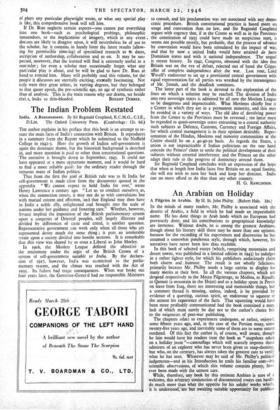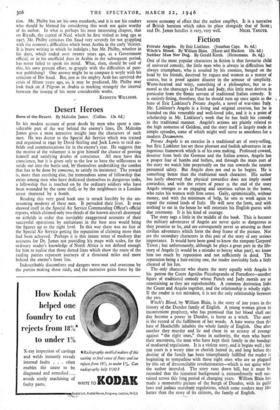An Arabian on Holiday
A Pilgrim in Arabia. By H. St. John Philby. (Robert Hale. 16s.)
IN the minds of many readers, Mr. Philby is associated with the deserts of Arabia, a field in which he had made an imperishable
name. He has done things in Arab lands which no European had previously done, and his contributions to geographical knowledge are immense. Without doubt, he is among the greatest Arabians,
though about his literary skill there may be more than one opinion, because for the recording of his experiences and discoveries he has assumed a somewhat ponderous style, through which, however, his narratives have never been less than readable.
In this book of selected essays (which, comprising mountains and desert towns, was published in a limited edition in 1943) he indulges in a rather lighter style, for which his publishers audaciously claim both charm and humour. The result is not wholly felicitous, primarily because Mr. Philby needs a large canvas to display his
many merits at their best. In all the various chapters, which are devpted respectively to the Mecca Pilgrimage, to Medina, to Riyadh, to Qarnait (a mountain in the Hejaz) and to a holiday spent in Persia on leave from Iraq, there are interesting and memorable things, but a common thread is missing, unless, indeed, it be provided by evidence of a questing, curious spirit, an endeavour to squeeze to the utmost his experience of the facts. That squeezing would have been more profitably communicated had the book contained a map, lack of which must surely be due not to the author's choice but to the exigencies of post-war publishing.
The chapters relate to experiences undergone, or rather, enjoyed, some fifteen years ago, and, in the case of the Persian essay, some twenty-five years ago, and inevitably some of them are to some extent outdated. Of this fact the author is, of course, well aware, though he fain would have his readers treat the book as " snapshots taken on a holiday jaunt "—camouflage which will scarcely impress those admirers of an explorer who has never been given to snap-shorting, but who, on the contrary, has always taken the greatest care to verify what he has seen. Whatever may be said of Mr. Philby's political judgements—and in his Introduction he trails his familiar coat—Ins scientific observations, of which this volume contains plenty, have ever been made with the utmost care.
While, therefore, any book by this eminent Arabian is sure of a welcome, this arbitrary conjunction of disconnected essays can hardly do much more than whet the appetite for his solider works which, it is understood, are but awaiting suitable opportunity for publica- tion. Mr. Philby has set his own standards, and it is not his readers who should be blamed for considering this work not quite worthy of its author. In what is perhaps his most interesting chapter, that on Riyadh, the capital of Nejd_ which he first visited as long ago as 1917, Mr. Philby criticises Ibn Saud very severely for not grappling with the econom'c difficulties which beset Arabia in the early 'thirties. It is brave writing in which he indulges ; but Mr. Philby, whether in his days, which ended over twenty years ago, as a Government official, or in his unofficial days in Arabia in the subsequent period, has never failed to speak nis mind. What, then, should be said of this; his own present effort, to grapple with the difficulties of post- war publishing? One answer might be to compare it wryly with his criticism of Ibn Saud. But, just as the mighty Arab has survived the crisis of fifteen years ago, so, it may be predicted, Mr. Philby may look back on A Pilgrim in Arabia as marking strangely the interval between the issuing of his more considerable works. -
KENNETH WILLIAMS.































 Previous page
Previous page